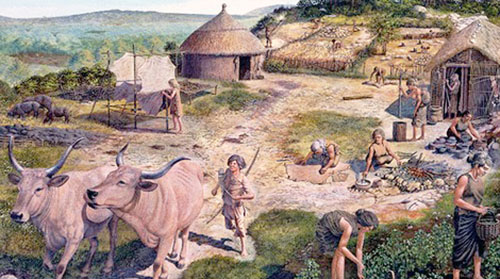Which PBs have we transgressed, and how do we know?
Firstly, it is important to note that in addition to quantitative methods, early-warning signs can indicate approach towards a threshold.
Statistically, the proposed PBs are placed significantly before reaching the threshold; the buffer in between accounts for uncertainty and the element of Surprise.
(Source: Science, 2015)
Of the PBs presently quantified, individual safe operating space and present positions are quantified to the following levels:
Climate Change
Based on IPCC reports in 2012 and 2013, the safe operating space is below an atmospheric CO2 concentration of 350ppm and an increase in top-of-atmosphere radiative forcing of +1.0Wm–2 relative to 1750. Human-driven changes to radiative forcing include CO2, other greenhouse gases, aerosols, and other factors that affect the energy balance. Present values are 406.75ppm CO2 and +2.3Wm–2. Hence, the boundary has been transgressed. Early-warning signs that indicate transgression are the increase in heat waves, the increase in heavy rainfall events, increased drought, and mass loss of ice sheets. The problem of system inertia needs to be taken into account in assessing the time needed for society to react to early-warning signs.
Ocean Acificiation
The boundary is defined as ≥80% of the preindustrial annual average global Ωarag. Present global value is 84%, within safe boundaries. It would not be transgressed if the Climate Change PB were respected, and system inertia means future risk will increase.
Stratospheric Ozone Depletion
Boundary of minimum ozone concentration is defined as 275DU. Concentration drops to 200 DU only over the Antarctica in the austral spring, transgressing the boundary regionally. This is the ozone hole. Global concentration has been steady for 15 years and is expected to rise as the ozone hole is repaired after environmental policy phased out ozone-depleting chemicals.
Ozone-Depleting Chemicals (Source: Ozone Assessment 2010)
(Source: Science, 2015)
I shall focus on those transgressed.
Biogeochemical Flows
The global-scale boundary for Phosphorus is set at a sustained flow of 11TgP/year from freshwater systems into the ocean. At a sub-planetary scale it is 6.2TgP/year from fertilizers to soils. The present global rate of application of Phosphorus to croplands is 14.2TgP/year, well above the PB. For Nitrogen, the PB for eutrophication of aquatic ecosystems is 62TgN/year, which we have significantly transgressed, at 150TgN/year. From the above diagram, the main contributors to these transgressions are a few agricultural regions of very high P/N application rates.
Land-System Change
The major forest biomes play a stronger role in land surface–climate coupling than other biomes. The biome-level boundary for tropical and boreal forests are set at 85% of potential forest, and that for temperate forests at 50%. The diagram above summarises risk of sub-planetary scale transgressions. The global boundary is set at 75% of original forest cover, which is transgressed: present forest cover is 62%. It would not be transgressed if the Biosphere Integrity PB were respected.
Biosphere Integrity
The Biodiversity Intactness Index (BII) assesses anthropogenically-caused change in population abundance across a wide range of taxa and functional groups at a biome or ecosystem level using preindustrial abundance as a reference point. Though the PB is set at 90%, the high degree of uncertainty, 30-90%, makes the present value, 84%, appear much less significant a transgression than represented on the wedge.
Atmosphere aerosol loading
The annual mean Aerosol Optical Depth (AOD) is presently at 0.3. The proposed boundary proposed is 0.25 (0.25-0.50), indicating transgression within the zone of uncertainty. A substantial decrease in monsoon activity can be used as an early-warning sign, and would occur at AOD 0.50.
(Source: Science, 2015)
From the supplementary materials, we find many additional proposals of methods and values for boundaries and present positions. The summary diagram in each paper, such as the one above, give us a general idea. One would have to complete many PhDs to understand the specific quantification methods behind each PB!
Which PBs should be policy priority?
The extent of transgressions informs policymakers of the urgency of each environmental problem. However, the paper has made it clear that there is a high degree of uncertainty in the quantification of each boundary and each transgression risk. Although control variable wedges have been normalized for the zones of uncertainty, the exercise of representing all PBs with vastly differing measurement units on one chart is like comparing apples with oranges.
The scale of tipping points determines importance of PBs to organisations of different scales. International organisations should prioritise planetary-scale tipping points, while smaller organisations may find it more effective to prioritise regional-scale tipping points.
From a Research perspective, the PBs yet to be quantified, as well as the highly uncertain PBs, represent gaps in knowledge and should be prioritised.
What PBs don't tell us
Since the PBs became influential in global sustainability policy development, many scholars have proposed supplementary or alternative PBs, and critiqued the PBs.
(Source: Science, 2012)
This paper questions the relevance of a global perspective for Biogeochemical Flows from a governance perspective. It may be more effective to address transgressions from a regional perspective.
Nevertheless, most see the usefulness of the concept.
































